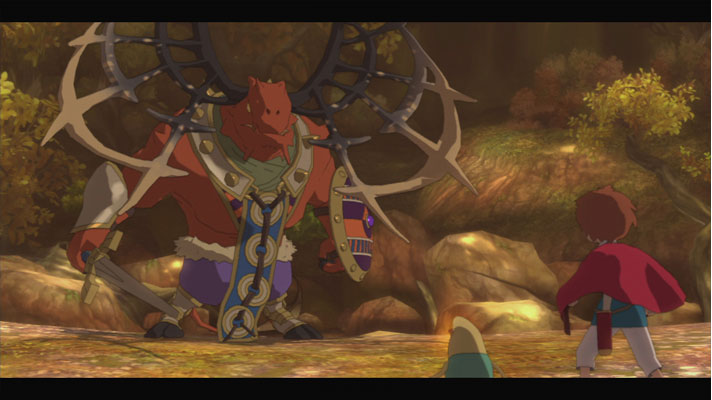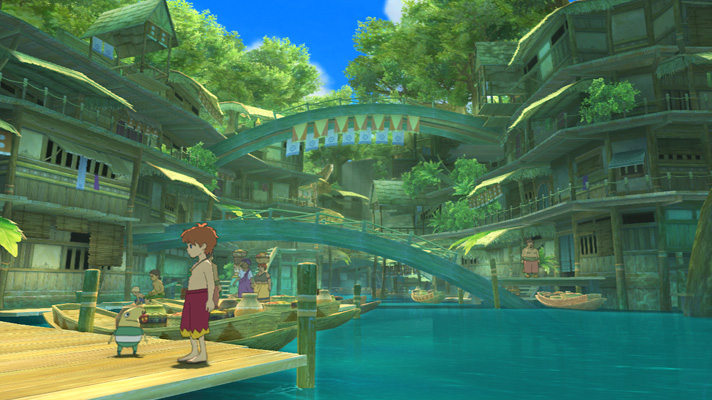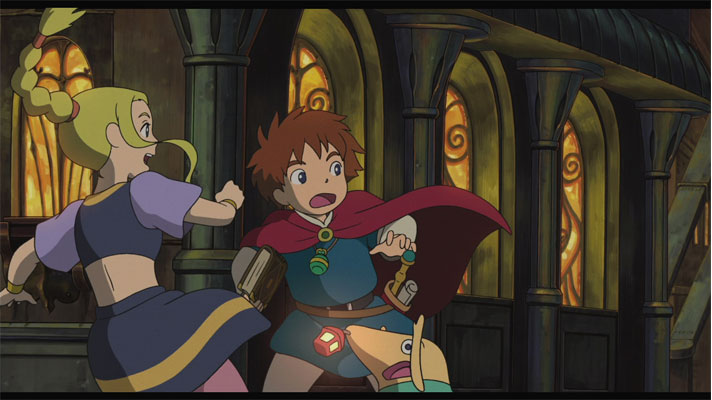Quick Search
Navigation
Featured Articles
- The Monsters of the Wailing Prison
- Strider Review
- BioShock Dev Irrational Fires All But 15 Employees
- New Titanfall Maps Confirmed
- There Are Aliens In Titanfall
- Guide: How to Dominate The Elder Scrolls Online PvP
- The Elder Scrolls Online PvP Experience
- Get Glow-in-the-Dark Condoms For Pre-Ordering InFamous: Second Son
- Batman: Arkham Origins Devs Have No Intention To Fix Bugs - Working On DLC Instead
- 8 Exclusive ESO Screenshots
Ni No Kuni: Wrath Of The White Witch Review
- 1-28-2013
- Categorized in: Reviews, Video Game News

Ni No Kuni: Wrath of the White Witch is a JRPG in the most classical sense. It pits a band of young heroes against a seemingly insurmountable evil on a journey that will take them around the world and back again. Along the way the heores will grow both physically and emotionally, forced as they are to confront both the world's atrocities and beauties in their quest for peace. Overworld maps will be traversed, levels will be grinded, and eventually a dragon will be tamed, allowing protagonist Oliver and his pals to fly from continent to continent.

All of this should sound incredibly familiar to anyone who picked up a Japanese role-playing game during the genre's SNES and Playstation heydays. Indeed, Ni No Kuni is classically influenced in the most significant of ways, and in less skilled hands that could make it feel archaic or dated. But Level 5 has brought to the table such sheer enthusiasm for their craft that it's almost impossible not to let a little rub off on you, and executed it all with such skill that you'll be hard-pressed to name a better JRPG this generation. And that makes Ni No Kuni the most exciting thing to happen to the genre, and to the Playstation 3, in a long time.
That's not to imply that the game's perfect, though; far from it, in fact. It's a bit of a slow starter, with the first hour and a half or so consisting mostly of conversations and cutscenes. You'll get to fight a few battles, but the full depth of the combat won't be revealed until Oliver gets his first companion around the nine hour mark. With Studio Ghibli at the game's artistic reigns, an abundance of cutscenes isn't as big a problem as it could be, but the game remains a bit top-heavy. This issue is expounded by Oliver's voice acting, which frankly just isn't as strong as it should be considering the sheer amount of dialogue in the game. Luckily, the other characters give it their all. Oliver's doll friend Mr. Drippy is a particularly strong character whose Welsh accent and vernacular inject a heaping helping of personality into every scene.
Once things have gotten going, you'll notice an abundance of battles on the game's overworld, which can also be annoying. There are no random encounters, and enemies are fully represented on the overworld map, but they'll chase you as soon as they establish line of sight and they're usually faster than Oliver. Fights are literally encountered every five to ten steps on the overworld map, and while this becomes less of a problem once the battle stystem starts to flesh itself out, it can be tedious in the beginning hours. Once Oliver reaches a certain level and begins to overpower enemies in an area, they will actually turn tail and flee instead of giving chase, which is a nice touch that eliminates unecessary battling.

It's a good thing, too, because overworld battles can be surprisingly tough. It's not uncommon to find yourself dead after three or four encounters in a new area, and while it's definitely satisfying to progress from the point of dying every three fights to the point at which enemies begin running from you, it also necessitates a bit of grinding. Plan on completing all of the side missions in the game if you have any intention of making it through Ni No Kuni alive. On the other hand, boss battles are strangely easy; most of them can be conquered by simply running around in circles casting spells.
These might be crippling issues for lesser games, but Ni No Kuni is so massive, so beautiful and just so darn charming that in the end they feel as mere trifles. This is thanks in some part to the feelings of nostalgia that spring from playing a game of this ilk again. It's been a long time since we've seen a game like this, one which emphasizes overworld exploration and storytelling to such great extent, and as ancient as some of Ni No Kuni's mechanics are, they feel oddly fresh as a result.
But when the nostalgia fades away, it's the raw depth of mechanics and abundance of heart that carries the game through its 60-hour runtime. Oliver's story is as classic a coming of age tale as there's ever been. After the abrupt death of his mother, his sorrow gives life to a stuffed toy that she once made for him. As it turns out there are parallel universes, and in one of those universes there's an evil wizard named Shadar who banished a fairy lord to Oliver's world. The fairy's spirit was trapped in Oliver's toy, and his tears broke the spell. Naturally, the fairy knows of a way to bring Oliver's mother back, so it's off to save the parallel universe the two go. It's charming stuff, and while the crux of the game lies in personal loss, Ni No Kuni's is a generally uplifting tale. There's a sense of whimsy and adventure inherent in the game that can easily spread to everyone in the room.

Playing the game is just as much fun. The battle system is a hybrid of real time and turn-based, with character movement occuring in real time but attacks happening on a timed basis. The most immediate comparison that springs to mind is Level 5's own White Knight Chronicles games, although there's an urgency to Ni No Kuni's battles that wasn't present in those games thanks to the difficulty level.
Capturing and taming monsters also plays a big role in battle. Ni No Kuni's charming little companions are called Familiars, and they come in a variety of shapes, sizes and genuses. Each character is proficient with different genuses of Familiar, and each genus is strong and weak towards others. You can power up your Familiars by feeding them snacks won through battle or found in chests, and evolve them using stones earned in the same ways. Evolving a Familiar resets it to level one, though, so there's a certain strategy to timing your evolutions so that you aren't overwhelmed in battle.
No review of Ni No Kuni would be complete without mention of the art style. Studio Ghibli's influence can be felt at a cellular level in this game; everything from the beautifully fluid cel shading on the game's main characters to the themes and dialects of the story is rife with the themes and stylings most prevalent in the storied team's own work. That said, if you're coming to Ni No Kuni hoping to see hours of animated cutscenes, think again. While prevalent in the beginning, the anime cutscenes become significantly less in number around the four hour mark, and are typically reserved as a reward for a particularly big boss battle or story beat. Using gorgeous cutscenes as a reward is another way in which the game reminds of some of the best JRPGs of old. The only difference is that the core gameplay looks stunning in its own way.

Ni No Kuni makes even the oldest of role-playing mechanics feel fresh again through its sheer enthusiasm for the tale it has to tell. There's nothing new about this package, but it's the way it's all presented that makes it something special. That, combined with some fantastically deep combat and lovely visuals, make Ni No Kuni a must for Playstation 3 owners.
Score: 8.5/10




